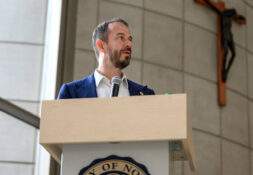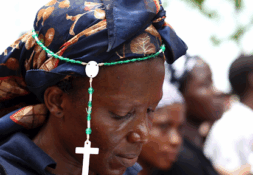“Issues in Sacred Architecture” class provides hope for architecture’s future
Renowned architect Duncan Stroik is demonstrating tradition’s current relevance in his Fall 2025 class titled “Issues in Sacred Architecture.” Open to undergraduate and graduate students from all disciplines, the course offers a profound perspective on historic sacred buildings that could help remedy contemporary architectural problems.
Stroik boasts decades of experience as a practicing architect, professor, author, and lecturer. His designs include Our Lady of the Most Holy Trinity Chapel in Santa Paula, California, the Cathedral of Saint Joseph in Sioux Falls, South Dakota, and the Shrine of Our Lady of Guadalupe in LaCrosse, Wisconsin. On campus, he also recently designed the Basilica Reliquary Chapel, dedicated in 2024.
The class has evolved over the years from a general historical survey of sacred architecture to a more specific case study that illuminates universal themes. It now primarily emphasizes Renaissance Venetian architecture, using Loren Partridge’s book Art of Renaissance Venice as its core text. Stroik explained, “I want to give them a little bit of a broad intro, but then we focus on Venice, with the idea being that you could take any country and any period and learn about it, [and] you’d actually learn some of the principles of sacred architecture of all time.”
To explain these core principles of sacred architecture, Stroik mentioned five ways to direct people towards God: “The first is transcendence. Churches should be upright or vertical, like the human being, and point you to the heavens. They should have a direction, so an orientation and a focus. We’re focused to the east. We’re focused towards the altar, or focused towards Christ. … Then the third one is what I call tectonics, which is that there’s a logic to the structure, to the way they’re built. … And then there’s geometry—that there’s a geometric rigor, and a mathematical rigor—and that is based on the idea that God is orderly. And then the last one is iconography, the most important one, perhaps—that it tells a story, tells a narrative, through art.”
Taken as a whole, these five principles offer a universal standard for the design of sacred buildings. Far from remaining overly formulaic, however, Stroik went on to explain how examining traditional buildings can inspire, rather than limit, students: “I’m interested in recovering lots of ways [to design churches], not the formula. I’m not against the formula. … But I’m interested in breaking through the formula and saying Catholicism doesn’t have a required image in the center.”
“We can come up with some new old ways of doing things—not really new, but new old ways,” Stroik continued.
The class also touches on a piece of sacred architecture close to home—the Basilica of the Sacred Heart. One of the first assignments involved a Basilica visit, and Stroik commented that “to some extent, we look at Venetian buildings in relationship to the Basilica [of the Sacred Heart at Notre Dame].”
Students have taken various insights away from the class. Erhan Osmani, a sophomore majoring in neuroscience, told the Rover, “I think the main purpose of the class at its basis is to think about why architects have made specific choices.”
Evan Hartman, a fifth-year student pursuing an MBA, expanded on the importance of knowing the ‘why’ behind architectural decisions. “I think that you need to explore the why, because I have people in my life who’ve argued, ‘Okay, the Church has spent all this money on architecture, why can’t they give it to the poor?’ You need to explore the ‘why’ in order to defend that. … I think that exploring the ‘why’ strengthens your faith and allows you to share with other people.”
Though the class highlights the great architecture of the past, students emphasized how it does not promote nostalgia but rather inspires contemporary and future greatness. Devlin Hose, a fifth-year architecture student, pointed out, “The only way that you can gather an understanding is doing an analysis of existing art and architecture. The better the art and architecture, the better the analysis. And you can then apply that to future work.”
Hose also noted that studying great architecture did not decrease his appreciation for humbler sacred spaces: “The spaces [Stroik is] presenting are really sublime sacred spaces. That’s not to say that you then walk away from that and say, ‘My local church is not the Cathedral of Venice.’”
When asked what he hopes his students get out of the class, Stroik told the Rover, “A fair number of Notre Dame student graduates will go on some day to have the chance to [help] renovate or build a church. And I hope that some of them will get involved. They will have a chance, because your parish, your cathedral, your high school chapel, whatever, they want to fix it up.”
Stroik concluded, “The other relevance is that I would like to think that these topics are appropriate for appreciating the House of God, and when you visit them, it enriches your experience and appreciation for why they were built, how they’ve been used, and how they’re still being used.”
Clare Hettich is a freshman from Potomac, Maryland majoring in the Program of Liberal Studies with a supplemental major in theology. For an amateur but enthusiastic discussion about sacred art, music, etc. at any time of day (or night), email her at chettich@nd.edu.
Photo Credit: Basilica di San Marco
Subscribe to the Irish Rover here.
Donate to the Irish Rover here.





